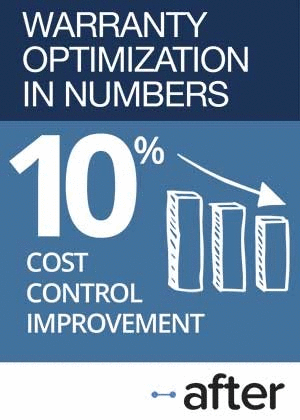Building Materials Industry
Warranty Report:
While some sectors have been able to reduce their warranty costs, others have seen them slowly rise. A few have seen costs rise as revenue falls, making warranty expenses even more painful to manage. But some have gotten their costs back under control after seeing them spike in recent years.
Warranty costs in the building materials industry, as in the medical equipment field, are usually kept relatively low, but occasionally get out of control. And because it takes a real crisis to drive up costs to painful levels, warranty isn't much of an issue most of the time.
In an industry with upwards of $135 billion in warranted product sales per year, warranty costs have remained close to $800 million for multiple years. That's roughly half of one percent of revenue. In contrast to the motor vehicle industry that we've already covered and the appliances and heating/cooling systems that we'll cover next week, warranty is just not much of an issue for most building material manufacturers.
For this week's report, we started with a list of 118 companies that provide builders and homeowners with fixtures, furniture or building materials. And we divided them into three groups: 28 manufacturers of fixtures such as lights and faucets; 34 furniture makers; and 56 suppliers of building materials such as paint, nails, tiles, shingles, carpet, doors and windows.
Unlike in our last examination of this industry in a newsletter a year ago, this time we did not include United Technologies Corp., the owner of the Otis Elevator Co., Kidde, and several other building material brands, because its sheer size would dominate its category. Besides, we covered the company as an aerospace supplier in the April 2 newsletter and will include it again in next week's report on major home appliances and HVAC system warranties.
We also did not include the warranty expenses of the homebuilders, which we covered separately in last week's newsletter, alongside the warranty expenses of the top RV manufacturers. Also, we're not including the forklift and material handling companies in this week's report. We're saving them for a separate report later in June.
So this week's report is just about the homebuilders' suppliers: the makers of the parts and pieces that go into new homes and office buildings, in addition to remodeling jobs on existing structures. Leading warranty providers in this industry include Fortune Brands Home & Security Inc.; Herman Miller Inc.; Illinois Tool Works Inc.; Masco Corp.; Mohawk Industries Inc.; Nortek Inc.; Owens Corning; Pentair Ltd.; RPM International Inc.; Sherwin Williams Co.; Stanley Black & Decker Inc.; and Tempur Sealy International Inc.
Declining Warranty Costs
In general, we find this group to have relatively low warranty expenses, both on a total dollar basis and as a percentage of their sales revenue. And while there has been a downturn in both their sales and warranty expenses in recent years, we find it to have been much less substantial than the near-depression conditions experienced by many homebuilders since 2008.
In Figure 1, we're totaling up the annual claims payments of the 118 suppliers that we're tracking. Total claims were actually up by about $58 million last year, to $856 million. Growth was fastest in the fixtures segment, which was up by $30 million to $232 million, and was slowest in the building materials segment, which was up by $13 million to a $421 million total. Furniture makers, meanwhile, saw claims rise by about $15 million last year.
Figure 1
Worldwide Warranty Claims
of U.S.-based Fixtures, Furniture
& Building Materials Companies
(claims paid in US$ millions, 2003-2014)

It was the second year in a row that claims payments rose, following an industry contraction that lasted from 2009 until 2012. From the peak to the trough, claims payments fell by about 30%, from an industry-wide total of just over $1 billion in 2009 to a low of $764 million in 2012.
But then in 2013 and again in 2014, claims began to slowly increase again. Tempur Sealy saw one of the biggest recent increases in claims payments, going from a $23-million payout in 2013 to a $36-million payout in 2014. But as its new corporate name suggests, it happened primarily because Tempur-Pedic is still absorbing the acquisition of the Sealy bedding brand name, and the increased costs that came with it.
Sherwin Williams is another company that saw a big jump in claims, going from $29 million in 2013 to $37 million in 2014. And both Owens Corning and Fortune Brands saw their claims payments rise by about a quarter in 2014. Others that paid out significantly more in 2014 than they did in 2013 include Acuity Brands Inc.; Crane Co.; Ply Gem Holdings Inc.; and Nordson Corp.
Warranty Accruals Slowly Recover
Notice in Figure 2 that the peak year for accruals is 2007 -- two years before the peak in claims. This is in keeping with the accrual method, under which you first set the money aside when an expense is predicted, and spend the money later when the bills actually come in. For the makers of building materials, sales peaked in 2007 and so did accruals. But it took another two years before claims peaked.
It's the same with the declines. There's a two-year lag time between claims and accruals. Accruals reached their minimum in 2010, two years before claims did. And the size of the drop in accruals is very similar as well: from a peak of $1.007 billion to a trough of $789 million -- a 32% decline.
However, 2014 was the second consecutive year of annual increases in warranty accruals. The overall total was up by $56 million last year, though most of that came from a big jump in accruals made by the fixtures companies. The furniture companies actually cut their accruals by a little bit, while the building materials companies increased their accruals only slightly.
This didn't correlate with sales, as we will see in more detail in Figures 4 through 6. The fixtures companies saw only a slight increase in sales, while the building materials companies saw a slight decrease. The big gains in sales were seen by the furniture companies -- the same group that cut their accruals. Usually, the combination of rising sales and falling accruals signals an increase in product reliability and a predicted decrease in claims cost in the future.
Figure 2
Worldwide Warranty Accruals
of U.S.-based Fixtures, Furniture
& Building Materials Companies
(accruals made in US$ millions, 2003-2014)

Among the largest warranty providers, Tempur Sealy saw its accruals total rise by more than half in 2014, as did RPM International. Others increasing their accruals by large amounts included Masco, Pentair, and Sherwin Williams.
But there were also big drops, such as Mohawk Industries' accrual reduction from $52 million in 2013 to $46 million in 2014. Louisiana-Pacific Corp. cut its accruals from $18 million to $11 million. Steelcase Inc. cut its accruals from $15 million to $13 million. And HNI Corp. cut its accruals from $22 million to $19 million per year.
Warranty Reserves Set Records
The net effect of these increases and decreases in claims and accruals is a change in the balance of the warranty reserve funds of the individual companies. In Figure 3 we're adding together the year-ending balances of the 118 companies we're tracking. As with accruals, the peak for this warranty metric came in 2007. But unlike the two previous metrics, the magnitude of the decline wasn't as pronounced.
From 2007 to 2010, warranty reserves for all three groups combined fell by $190 million, or by roughly 14% of the peak balance. That compares to declines of 30% and 32% respectively for claims and accruals.
In 2014, the combined balances fell by another $26 million, with a gain by the fixtures companies more than offset by declines in the other two segments. However, also note that despite the overall decline, the year-ending balance of just the fixtures companies set a record in 2014, something the furniture companies did the year before. So not every metric has peaked.
Figure 3
Worldwide Warranty Reserves
of U.S.-based Fixtures, Furniture
& Building Materials Companies
(reserves held in US$ millions, 2003-2014)

Among the larger warranty providers, Stanley Black & Decker reduced its warranty reserves by $12 million, to a 2014 balance of $110 million. Proportionally, the reductions by Fortune Brands and Mohawk were larger, but they were smaller in terms of money. Steelcase cut its reserves balance almost in half, from $36 to $19 million.
Ply Gem, which makes windows, doors, and siding, made a mammoth change in estimate last year that ended up doubling its reserve balance from $42 to $84 million. Hubbell Inc., a lighting manufacturer, also doubled its reserve balance, from $7 to $14 million. Outside of those two, some of the biggest increases were seen at Pentair (+$10 million) and Masco (+$11 million), though proportionally one of the biggest was Tempur Sealy's jump from $26 to $31 million.
Declining Warranty Expense Rates
For the charts in Figures 4, 5 and 6, we took the claims and accrual totals from Figures 1 and 2 and divided each of them by the corresponding sales totals. This results in three charts measuring the claims rates and the accrual rates, with the warranty expense expressed as a percentage of sales revenue.
The claims rate is heavily affected by changes in sales. But the accrual rate should remain about the same, because accruals should rise and fall in proportion to sales, unless there's been a change in reliability or repair cost. So let's start out by saying that sales didn't rise by much last year but both claims and accruals rose faster than sales. In other words, there's been a rise in repair costs and a drop in product reliability.
The 28 fixtures companies saw a 2.7% increase in sales, versus a 15% rise in claims and a 26% rise in accruals. And therefore it should come as no surprise that both the claims and accrual rates in the figure below were higher in 2014 than they've been in recent years.
Figure 4
U.S.-based Fixtures Companies
Average Warranty Claims & Accrual Rates
(as a % of product sales, 2003-2014)

The fixtures companies hit their all-time low in early 2013, when their average claims rate was 0.42% and their accrual rate was 0.44%. We're measuring changes in hundredths of a percentage point because the truth is that the averages haven't moved around much for the past 12 years. For instance, the highest-ever expense rate for this group came in late 2009, when the average claims rate rose to 0.85%. That means all this data is in a range that's only 0.43% wide. In some industries, that's the size of the quarterly fluctuations.
Fortune Brands made two appearances in the top 10 lists detailed in the March 12 newsletter, which spotlighted the companies whose expense rates changed the most. In their case, both expense rates soared in 2014, as did Pentair's accrual rate. None of the largest fixtures companies saw their expense rates drop precipitously, though among the smaller companies both Powell Industries Inc. and W.W. Grainger Inc. saw declines in their claims rates, and Grainger also cut its accrual rate.
Slowly Increasing Expense Rates
The furniture companies, meanwhile, saw a 17% increase in sales but only an 8% rise in claims and a $7 million decline in accruals. As can be seen in Figure 5, this combines into a big drop for this sector's expense rates from the end of 2013, though there's a little more volatility in the data overall.
As with the fixtures companies, expense rates for the furniture companies plummeted in early 2013, though not to record low levels. And their average claims rate also hit a record high in 2009. Overall, the trend for this segment since 2003 has been for warranty expense rates to rise slowly, with some big ups and downs along the way.
Figure 5
U.S.-based Furniture Companies
Average Warranty Claims & Accrual Rates
(as a % of product sales, 2003-2014)

Tempur Sealy was the only large furniture company to see a big jump in expense rates, though smaller furniture companies such as Select Comfort Corp. and La-Z-Boy Inc. also saw big jumps in their expense rates.
At the other extreme, Trex Company Inc. cut its accrual rate to 0% in 2014 and paid its $8.9 million claims bill by running down its reserve balance, letting it drop from $40.3 million to $31.4 million. V.F. Corp., Knoll Inc., and HNI Corp. each reduced their claims rates by about 0.2%, and cut their accruals by similar amounts.
Slowly Decreasing Expense Rates
Overall, the average warranty expense rate for the 56 building material companies has remained very close to 0.48% for the past eight quarters. They were somewhat above this average from 2003 to 2010, and somewhat below it in 2011 and 2012. Meanwhile, the decade-long trend shows a very slight decline, except during the recession, when claims rates went a bit wacky in this segment.
In Figure 6, the most notable feature of the expense rate chart is the sudden drop-off in the averages in 2011 and 2012, followed by a return to trend in 2013 and 2014. It's primarily the result of Mohawk Industries getting its warranty expenses back under control in 2011, and secondarily by some smaller expense rate reductions in that year by Lincoln Electric, Ply Gem, and Sherwin Williams. But it's also somewhat of an optical illusion, caused by the extremely stretched nature of the vertical axis. As with Figure 4, most of this data fits within an 0.50% range from the lowest to the highest point.
Figure 6
U.S.-based Building Materials Companies
Average Warranty Claims & Accrual Rates
(as a % of product sales, 2003-2014)

There's quite a bit more change among the individual companies. Acuity Brands saw a massive increase in its claims rate, and in response it raised its accrual rate from 0.2% to 0.5%. Mueller Water Products, Powell Industries, and Hubbell saw their claims rates fall, but raised their accrual rates anyhow. Masco and Pentair saw slight rises in their claims rates, but made somewhat larger increases in their accrual rates.
In total, this segment saw a slight decrease in annual sales of warranted products in 2014, coupled with slight increases in its claims and accrual totals. As a result, there is very little change in Figure 6 between the data points for 2013 and 2014.
Correlating Accruals and Sales
And as for the idea that accruals should remain proportional to sales, and the accrual rate should therefore remain stable, this doesn't seem to be the case, at least among the larger companies we're tracking this week. Therefore, either the vast majority of companies are seeing big annual changes in product reliability or repair costs, or they're not really accruing a set amount of money per product sold.
Among the 24 fixtures, furniture and building material companies with warranted product sales totals above $1 billion in 2013, only six saw sales declines in 2014: Armstrong World Industries Inc.; Axiall Corp.; Fortune Brands; Lincoln Electric Holdings Inc.; Owens Corning; and Pentair. Of those, only Lincoln Electric, Armstrong, and Axiall saw their accruals change at similar rates.
Among the 18 that saw sales increases from 2013 to 2014, only six saw proportional accrual increases: Associated Materials LLC; Illinois Tool Works; Ply Gem Holdings; Stanley Black & Decker; V.F. Corp.; and W.W. Grainger. Actually, Associated Materials saw a 1.5% sales increase and a 1.1% accruals decrease, but the gap between those rates -- 2.6% -- was among the smallest seen.









